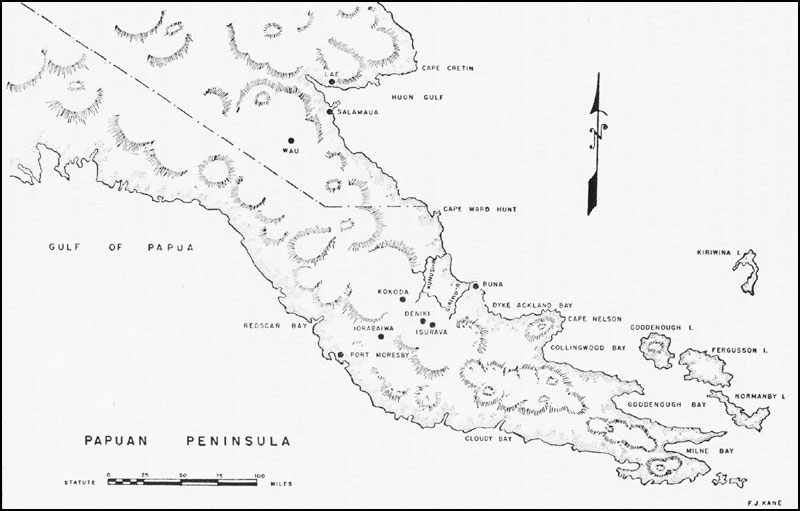But things were still unsettled in New Guinea.

During the early days days of September the Directorate of Air Transport had pressed every available plane, whether civil or military, into service to ferry an Australian regiment from Brisbane to Port Moresby. By 15 September, the exhausted troops facing the Japanese in the ridges above Port Moresby had been reinforced by three fresh Australian battalions; and on that same day the first American infantrymen to reach New Guinea, Company E, 126th Infantry of the 32d Division, landed by transport plane at Seven-Mile Airdrome. This had been a test flight to determine the feasibility of moving units by air transport, and by 24 September the 128th Infantry Regiment, less artillery, had been flown to Port Moresby, where the remainder of the 126th Infantry came in by water on 28 September. On that day the reinforced Australians launched an attack which broke the enemy's defenses on Iorabaiwa Ridge and then in the face of tenacious resistance forced their way back toward Kokoda. Though it would take over a month to reach that place, with its useful airfield, the turning point in the Japanese attempt to take Port Moresby from the rear had come. Bitter fighting lay ahead, but the battle soon would be for Buna instead of for Moresby.
It had been necessary for army air force leaders to divide their attention between operations and reorganization. General Kenney had been preceded to Australia by Brig. Gens. Ennis C. Whitehead, an experienced fighter commander, and Kenneth N. Walker, expert in bombardment aviation; Brig. Gen. Donald Wilson, whom Kenney proposed to use as chief of staff, soon followed. Plans, on which General Kenney had been briefed in Washington, called for organization of American units into a distinct air force that would be largely free of obligations for the immediate defense of Australia in order to concentrate on support of a rapidly moving offensive to the north. On 7 August, three days after Kenney assumed command in Australia, MacArthur requested authorization for an American air force and suggested the designation of Fifth Air Force in honor of his fighter and bomber commands in the Philippines. This request was promptly granted, and the Fifth Air Force was officially constituted on 3 September. Kenney immediately assumed command, retaining in addition his command of the Allied Air Forces.
Problems of maintenance loomed large. In August Kenney described maintenance on his B-17's: "We are salvaging even the skin for large patchwork from twenty millimetre explosive fire; to patch up smaller holes we are flattening out tin cans and using them. Every good rib and bulkhead of a wrecked airplane is religiously saved to replace shot up members of other airplanes. Lack of bearings for Allison engines grounded many fighters; requisitioned in August, the bearings were not available for shipment until October, by which time main bearings in five out of six engines needed changing. Improper tools for Pratt & Whitney engines delayed repair of grounded B-26's and transports. Most discouraging of all was the difficulty getting the P-38's ready for combat. By October approximately sixty of these fighters had reached the theater, but none had seen combat. First, the fuel tanks began to leak, requiring repair or replacement, and then superchargers, water coolers, inverters, and armament all required major adjustment or repair. As a consequence, it was not until late in December that P-38's flew a major combat mission over New Guinea.
While preparing for the eventual move to New Guinea, the 27th Air Depot Group, trained and organized to rebuild aircraft, joined in the effort to keep the aircraft flying.




No comments:
Post a Comment